Author: Geoff Richards
Published: 18th October 2005
Published: 18th October 2005

When most think of drivebay LCD displays, they think of just one company: Matrix Orbital. With good reason too - they make some of the best programmable LCD displays on the market, and have been doing so for the past decade. It is nearly 4 years now since bit-tech reviewed Matrix Orbital's first PC-based products, and we have closely followed their progress ever since.
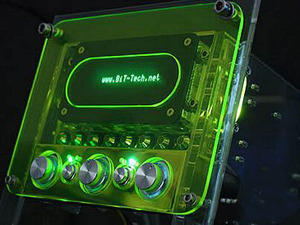

Matrix Orbital displays have featured in a number of our big case mod projects over the years: most people would instantly recognise Orac³ and Vesperdeco (pictured) and resident Grand-daddy of modding, Dave 'Macroman' Williams, is a fan, employing them for both Project 3G Clear and Macro Black. Over the years, there has been no finer LCD display than a Matrix Orbital.
What the modders innovate, the mainstream imitate
While the hardcore modders live on the bleeding edge, blowing up various components at their own expense in the pursuit of their latest mad invention, there is an entire industry of mainstream manufacturers trawling the internet trying to spot the next must-have product in waiting.Take LEDs fans and window-modded cases. To modders, they are so 2001, but walk into any mainstream computer store these days and you will see that both concepts are now truly mainstream. Blowholes? Rounded cables? Watercooling? All have the modding community to thank for daring to wonder 'What If?', one rainy Saturday afternoon, years ago.
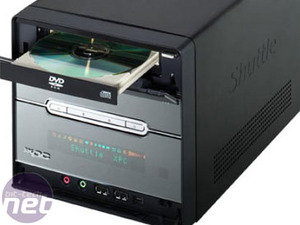

Naturally, the idea of front-mounted LCD displays aren't immune to this process, and Shuttle have recently incorporated a VFD to the front of their Media Center-ready SB85G5M barebones, set to display song titles, DVD timecodes and other useful information. Naturally, we found a couple of hidden uses when the case was shown to us at Computex 2005. Shuttle have also used the same VFD in their just-announced XP Media Center.

Of course, such displays are becoming quite commonplace, thanks to the explosion in the Home Theatre PC market. beblu's Media Center has a neat, four line LCD which displays all the information you need in clear, white text on a blue background. Information like track title and duration are automatically output to the LCD by Media Center.
With front-mounted LCD displays now firmly in the mainstream, are the days of the discrete, programmable LCD display numbered? We grabbed the most recent model from Matrix Orbital, th MX6, to find out.
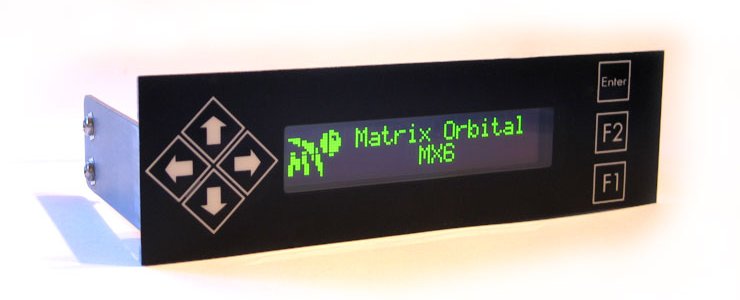
he Bundle


First impressions are good. The display comes packed securely in a very sturdy box, so wherever you live on this blue planet of ours, you can be sure your MX6 will arrive in one piece. Sadly, the same cannot be said of every sample we receive. Everything comes neatly bagged, and the display itself has an extra layer of bubble wrap just to be safe.


The model we received dispenses with the old RS232 serial interface for the more modern USB. As standard, the MX6 comes with a USB cable which loops out the back and into a rear USB port (see installation). If you have internal, on-board USB headers on your motherboard, you can order the optional internal USB cable. This gives a neater result, and saves you a rear port. Both cables are sleeved in sexy silver braiding. Also from the options list is a pair of external temperature probes.


Straight out of the box, the MX6 displays the usual Matrix Orbital quality. Solidly built, it weighs a purposeful 180g or so with USB cable - this is certainly no cheap, flimsy Made In China plastic garbage. The chassis is made from 2mm steel and doesn't bend under stress. This model - the MX610 - has the multi-function keypad, but you can also buy the same display with a plain bezel for a cleaner look (MX620 / 630).
All displays in the MX6 series are 20 x 2, meaning there are two rows of 20 characters. Unlike many other Matrix Orbital displays, which use a Vacuum fluorescent display (VFD), the MX6 uses a Polymer LED screen. PLED has the advantage of lower power consumption, a very wide viewing angle (160 degrees) and a fast response time / pixel refresh rate.


Moving around to the rear reveals the inner workings. The PCB is in two layers: the first is dedicated to driving the display, while the outer layer handles I/O. On the left are three channels for the temperature probes, while next to it are three General Purpose Outputs (GPOs) which can be used for fans. There is also a floppy drive power connector if more power is required than the USB port can provide - 150mA for an unpowered hub; 500mA from a high powered USB port.
Hardware installation
The physical installation, at least in theory, couldn't be easier - just plug it into a USB port, and you're done. In reality, the quirks of our test rig made things a little more challenging.The first obvious issue is that we have an Antec Sonata - an all round great case by all means - however, it has a door that stealths the drive bays. Fortunately, it can be removed, but in truth, any front-mounted LCD like the MX6 is far better suited to doorless cases like the Lian Li PC60 we used for Project Synapse.
The second issue is more serious. The Sonata, and many other cases, employs quick release rails for its 5.25" drive bays: screw them to your DVD drive, and you can slide it in / out just by pinching the tabs. This means none of the usual mucking around with mounting screws, and wondering if you put any on the far side that you can never reach. This is a problem because the mounting tabs on the MX6 are only only 60mm long - long enough to line up with the first row of mounting holes on a conventional case.


The solution was only partially successful: mount the rails as normal, using only the first set of holes, and just tighten the screw really tightly. The display slides into place and the tabs lock into place, but not securely enough to press the keypad buttons without the whole assembly sliding back inside the case. Prospective buyers with quick release cases like the Sonata might want to consider their mounting options carefully.


As mentioned earlier, the standard design uses a loop-through USB cable, passing out through an empty PCI backplate and into a rear USB port. If your computer room is as dusty as ours, we'd strongly recommend opting for the internal USB cable and keep that rear PCI plate screwed in place. With power applied, we are greeted by a funky welcome message.
Software installation
The software installation was far easier, thanks to USB.

Just pop the mini CD into the drive (slot-loading users beware!) and participate in the familiar Next - Next - Next - Finish ritutal. The MX6 was detected first time, and the drivers on the CD worked like a charm. Now that Windows knows it's there, it was time to install some software to make it display something useful.
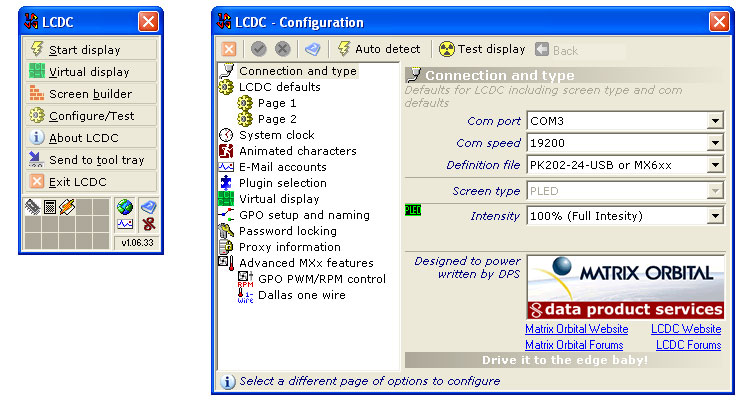
Matrix Orbital bundle LCDC, which would otherwise cost US$19.50 +VAT. LCDC is what you use to program the MX6 (and all other Matrix Orbital displays) to display information on the screen. 'Program' is the operative word - as we will discover, this is no fluffy, Wizard-driven application. Gone are the days when such displays required Visual Basic skills to program your own interface, but users expecting a friendly GUI with simple menu options will very quickly break into a nervous sweat and start reaching for the PDF manual.
Let the fun begin...
LCDC Tutorial
The heart of LCDC revolves around the Screen Builder. Here you can define one, or several, screens to display on your MX6. The can be pure text or you can design your own logos. Using plugins available for common programs such as Winamp, you can import variable such as Track Name and Time Remaining to design your own interface. Here is a simple, plain text example: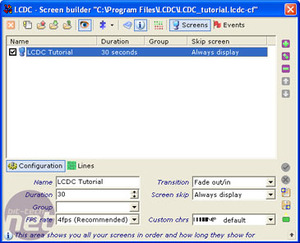
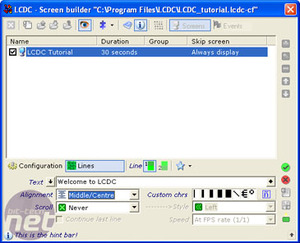
click for full size
Having created a blank screen, we can name it, set its duration, frame rate and decide on the transition between this screen and any subsequent one. The Fade in/out is particularly sexy. Moving to the Lines screen, we simply type into the text box for Line 1 and Line 2 respectively and set variables like Alignment and Scroll. The text appears on the display as you type it:
Moving on to something more useful, we created a quick Winamp screen to display our music information. There are a few pre-defined screens included with the software - to display the time for example - but we preferred to make a custom Winamp screen.
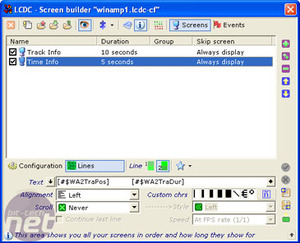
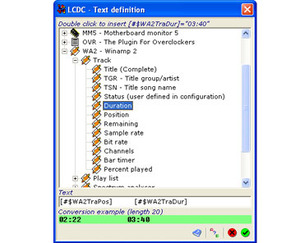
click for full size

After much frustrating research, we discovered we were missing a program: Char Mapper. Rather than a nice bitmap conversion program, to display a graphic or logo using LCDC, you have to create a Custom Character set with the image chopped up into the appropriate 5x8 pixel chunks per character.
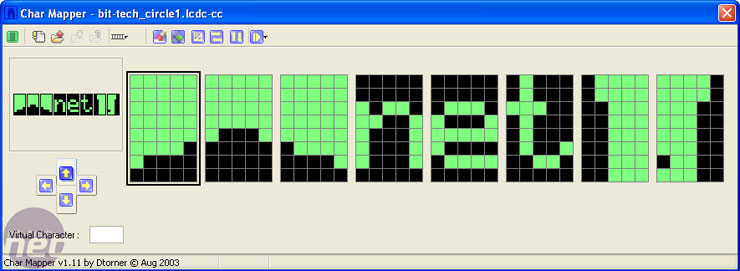

While there is a Motherboard Monitor plugin, and can directly support three temperature probes, we found the work required to build the necessary screens and programming the GPOs using LCDC to be more work than it should be. Anyone just wanting to know the temperature of their PC's innards would be better buying a cheap LCD probe for a quarter of the price.
We got there in the end, but the experience raises an interesting question: would you rather total control or ease of use?
LCDC will allow you to output virtually anything to the MX6, but Matrix Orbital themselves admit that 'the learning curve is steep'. For many enthusiasts, programming innovative new screens is part of the experience - many feature clever animations and other advanced tricks. However, for the part-time geek just wanting to put a cool LCD on the front of his HTPC, having to program things themselves will be daunting.
There is, of course, an active LCDC Community on hand to help out new users, but we would have preferred to see more pre-defined work included on the CD, and an easier-to-use way to display the most common functions than using the overly complicated LCDC.
Alternatives
There are now a number of options available for users wanting to display information on the front of the computer; options that didn't exist 4 years ago when Matrix Orbital first became popular with modders. Before we can pass judgement on the MX6, we need to look at the alternatives.Option A: PSOne LCD mod
Cost: £26.99 / US$34.99From: eBay
Difficulty: Moderate
bit-tech regular Brian Walker aka bEE2643 was one of the first people to perform this mod, way back in July 2004. Essentially, it involves buying a cheap Sony PSOne LCD from eBay, stripping it down, mounting the display somewhere cool, and hooking it up to the TV-Out of your graphics card. We have a detailed article titled PSOne LCD in a PC and the related Forum Thread has become a central meeting point for many modders to ask questions and help each other.
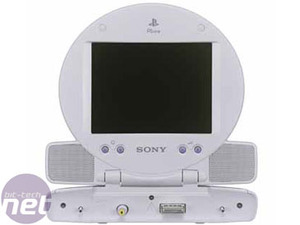
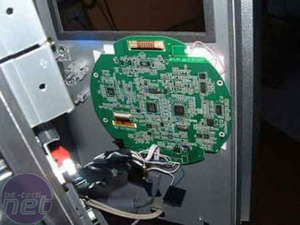
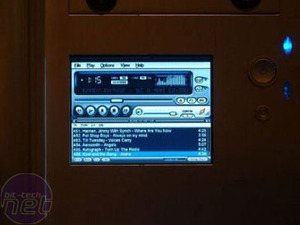
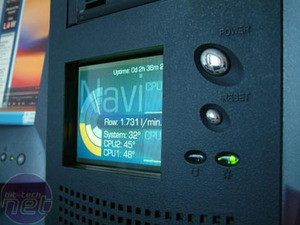
4 hours later, and you have your own 5-inch, 640x480 TFT capable of displaying anything your heart desires. You just set it as your secondary display, and you can use an extended desktop to position any window into place. Winamp is naturally a popular option. Alternatively, you can use Samurize to display some seriously funky stuff, like Nexxo's Project Metaversa (right), detailing crucial temperature and waterflow information.
Option B: In-car LCD mod
Cost: £60-150 / US$120From: eBay or various stores
Difficulty: Moderate
This mod is very similar to the PSOne mod above, but uses more sophisticated LCDs designed for in-car DVD systems. Most are 7-8 inches across and many are 16:9 widescreen. The more expensive ones even have touchscreens. Specifications vary wildly, with resolutions as low as 320x240, but KustomPCs sell a one capable of 800x480. eBay is a good source, though most sellers ship directly from Hong Kong or China, so it isn't for the timid.

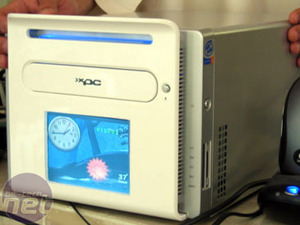
Mounting options are similar to the PSOne mod. One cool option would be to buy a motorised in-dash screen and mount it in a drive bay under your DVD writer. One touch of the button, and out pops the LCD - the ultimate LAN party showboating feature. Abbas Jaffarali at Tbreak.com gets a special mention for creating a really nice example using a Shuttle SB86i and a 5-inch car LCD.
Option C: 14"-17" TFT monitor mod
Cost: from £100 / US$170From: NewEgg or various stores
Difficulty: Moderate
Now that desktop LCD prices have fallen through the floor, turning an entire [/i]side[/i] of your PC into a display is now within the budget of many modders. bit-tech forum regular, CharlieCat, is a veteran at this one - he has now created three systems using this technique.

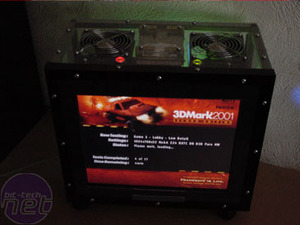
Depending on the size of your case, and the size of your budget, you can pick up a bargain 15" LCD for around £100; NewEgg has several models for US$170. The resolution will be 1024x768 and the viewing angle will be pretty rubbish, so you might be better off saving up a few extra pennies and plumping for a 17" model. Just £125 / $200 will net 17 inches, 1280x1024 and a 12ms refresh rate.
Option D: New case with LCD
Cost: from £188 to £500From: Kustom PCs or Scan
Difficulty: Easy
There are off-the-shelf options, including the Shuttle and beblu systems already mentioned, the latter available in a case-only option. Another leading manufacturer in this field is Silverstone - they make several cases that feature bezel-mounted VFD displays similar to the Matrix Orbital's range.
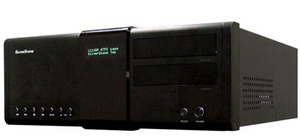
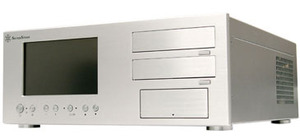
Most of the range have a stylish A/V receiver-look to their appearance, like the LC14BM (left). Truthfully, they are all available without VFD also, for considerably less. The most famous Silverstone case of them all is the LC18 (right), which sports a 7" touchscreen LCD on the front bezel as standard. However, at £500 from Scan, you certainly pay a premium for not doing the work yourself.
Conclusions
Back when this trend began, your choice was simple: Matrix Orbital or Crystal Fontz. The concept was new, so high prices, small sizes and DIY software was part of the adventure. However, that was four years ago now and in 2005, our expectations are vastly different.Matrix Orbital displays have always been extremely well made but also expensive, and this extends to the MX6. US customers will pay US$109.99 for the display plus accessories. KustomPCs sell them in the UK, but with the extra shipping and VAT, the price blows out to £76. However, the 20 x 2 configuration of the MX6 is somewhat limiting: it occupies a full 5.25" drive bay, yet you can only display 2 lines of text at a time.
We found most of the community-made screens and animations aimed at the larger 20 x 4 models, showing that most customers (quite rightly) prefer the extra real estate of the four-line displays. Matrix Orbital don't offer a four-line PLED display, so by the time you switch to the more expensive VFD technology and supersize an extra 2 lines, you're looking at an MX5 for US$149.99 / £98.99.
At that price, you're looking at three times the price of a PSOne LCD mod, and rapidly approaching the budget required for a 15" LCD monitor mod. Even the cheaper two-line MX6 is twice the price of a PSOne project.
You would hope then that Matrix Orbital's software bundle would rescue the situation, but sadly, it too is stuck in a time bubble. There is no denying that LCDC is very powerful. All credit to the LCDC team: for what is essentially a homebrew application, it offers fine control over every facet of the MX6's feature set. Without it, people would probably be left to code their own software.
However, it is far from polished and while we didn't experience any bugs per se, the hoops the user is required to jump through to output information to the screen leave much to be desired. From a usability point of view, it is arguably software designed by programmers, for programmers - code-shy novice users beware.
Considering that HTPC enthusiasts would be a large part of the MX6's target market, it is positively criminal that it is not Media Center compatible. Again, if one had the determination and skill, one could use LCDC to produce your own custom screens to display various HTPC activities. If you were seriously hardcore, you might even code your own Media Center plug-in for LCDC. However, having forked out big bucks for this display, this functionality should be a mere installation wizard away - it should not be down the community to write their own software.
If the MX6 was £20, you might be more forgiving, considering the additional sensor inputs, fan headers and general potential to make it do whatever you want it to do. At four times that price, functionality should be delivered on a silver platter, not be a box full of Lego. Faced with cheaper alternatives with far greater abilities, it is hard to recommend the MX6 to anyone but the most hardcore fanatic.


















Sem comentários:
Enviar um comentário